The 3-D printing revolution

"3-D printing"—the popular name for "additive manufacturing"—has been identified as one of the coming cluster of "disruptive" technologies. Expectations are that it will be a way—not the only way—to make all sorts of stuff. Food. Toothbrushes. Shoes. Art. Building materials. Car dashboards. Moon habitats. Transplantable human organs and living tissue for medical research.
With this technique, objects are built up in layers—sometimes only microns thick—in three dimensions. In the past couple of years, boosted by the unique nexus of the Internet, a culture of collaboration and open-source approaches, and breathtaking advances in software and computing power, 3-D printing is starting to hit the mainstream. And it is sparking innovation through advances in computer-aided design (CAD) software, and the Internet as it connects researchers, tinkerers, and entrepreneurs.
A 3-D revolution in the classroom
Richard Devon, professor of engineering design in Penn State's College of Engineering, and instructor David Saint John are guiding a growing number of engineering students to build printers to learn the technology from the inside out. They've built and shared printers with Mark Shriver in the Department of Anthropology, and he has used it to scan and "print" faces. Another is with the Department of Material Sciences and Engineering, and another is slated to go to Penn State's architecture school. Work with 3-D printing to fabricate models and practical-use objects is happening across the University, including the Penn State Lunar Lion project and the Applied Research Laboratory.
Saint John said that rather than waiting for funding, he opted to buy his own kit. "When I got my kit running, Richard was willing to post a course where we built our own printers, which I had the opportunity to run," he said.
With content and course expectations in place, eleven students signed up for spring semester 2011, working on three kits. More than twice that many students took the course the second semester it was offered, and during the third semester, a print service began, offering printing of prototypes for other students.

By the end of fall semester 2012, forty-two students had built four printers and created a blog about the course.
During spring semester 2013, twenty-three students worked on six new machines, for a total of about a dozen systems. One was delivered to the Department of Materials Science and Engineering, to print pastes as well as polymers, and one to Penn State Brandywine.
A boost to the new space industry
According to Michael Policelli, graduate student in aerospace engineering and chief technologist for the Penn State Lunar Lion X Prize Team, as the technology's use and acceptance within the aerospace community grow, 3-D printing will be a cornerstone of the new space industry.
"The Applied Research Laboratory is beginning to leverage our extensive capabilities and experience to develop the next generation of spacecraft components and hardware," he said. "The Lunar Lion team is already building partnerships with companies to build additive manufactured rocket engines with advanced geometries—and dramatic cost and schedule benefits."
Devon ponders the global economic impact of the disruptive nature of an emerging manufacturing process, but notes that 3-D printing won't be able to replace everything.
Saint John said it is a technology that allows people to achieve more than they might if they didn't have a 3-D printer. "In our experience," he said, "it helps speed up the development cycle, whether that's the development of a business prototype or the development of the student's capabilities."
Provided by Pennsylvania State University



















